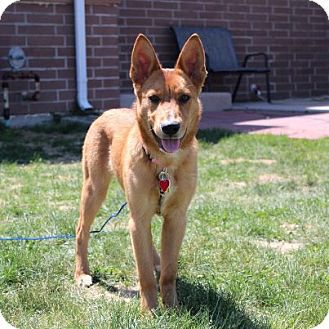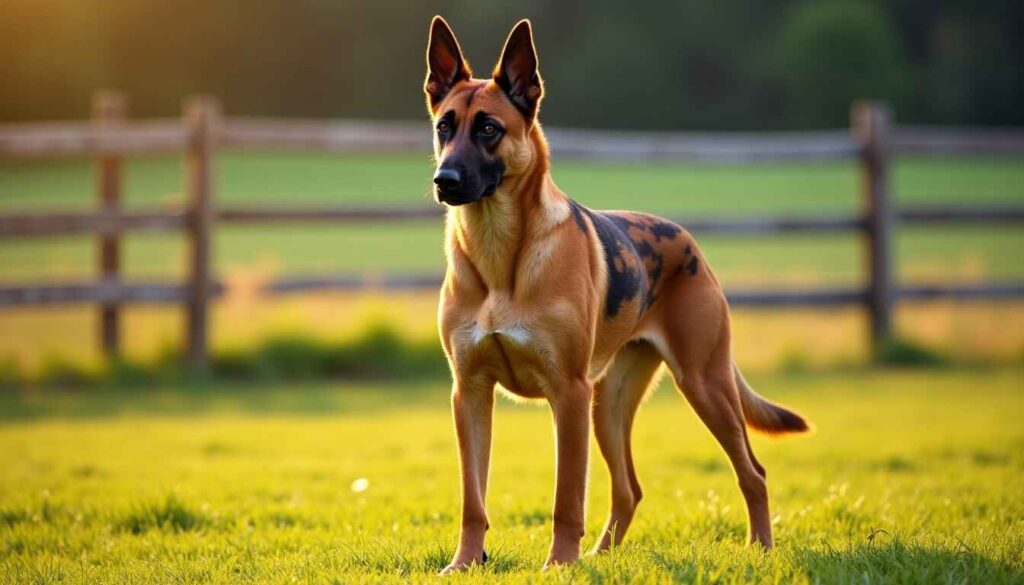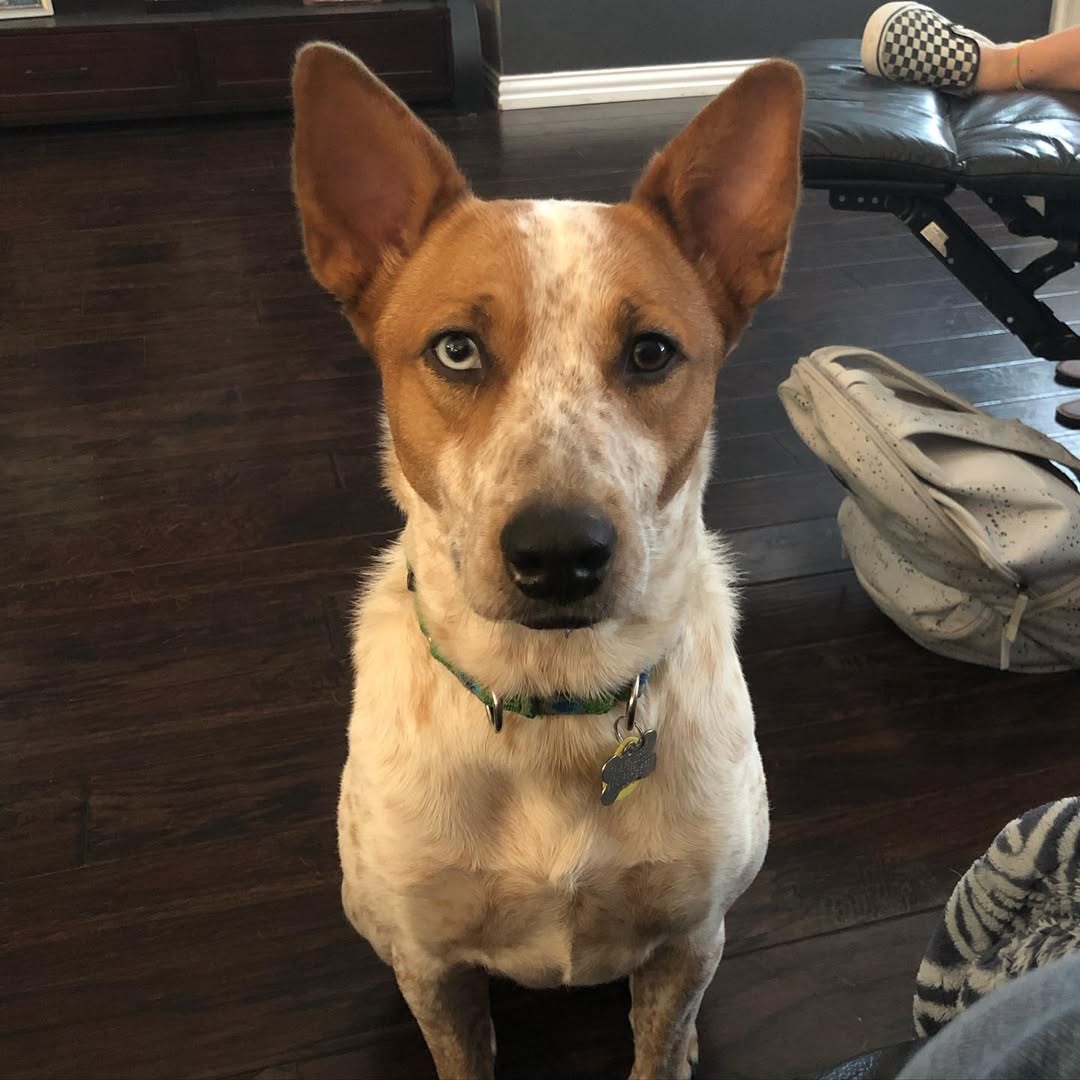The German Shepherd Red Heeler mix creates an impressively versatile companion by combining two of the hardest-working dog breeds. This energetic hybrid stands and weighs between 45 and 80 pounds. These dogs typically live 11 to 14 years, which means a long-term commitment for any dog lover 20 to 25 inches tall
The German Shepherd and Heeler mix passes down a remarkable blend of traits from both parent breeds. This unique hybrid shows off the Cattle Dog’s strong work ethic that comes from their history of herding cattle. The German Shepherd’s protective instincts shine through from their legacy of police and military service. On top of that, it needs 60 to 90 minutes of daily exercise, which makes it perfect for active families. Their loyal and protective nature means they fit better in households with older children. In this piece, you’ll discover everything you need to know about welcoming this remarkable hybrid into your home.
Choosing a Red Heeler German Shepherd Mix Puppy
Choosing the right Red Heeler German Shepherd mix puppy just needs thinking. This hybrid brings together two intelligent working breeds with strong personalities. Your search for the perfect Cattle Shepherd mix should start with understanding both parent breeds’ inherent traits and health concerns.
What to expect from a Red Heeler German Shepherd mix puppy
Red Heeler German Shepherd mix puppies inherit determination and intelligence from both parent breeds. These puppies show remarkable energy levels early, and they just need substantial mental and physical stimulation to prevent destructive behaviors. Their willful and obstinate nature makes early training vital.
Your German Shepherd and Heeler mix puppy’s personality remains unpredictable since they might favor either parent breed. Notwithstanding that, certain traits stay consistent – they’re loyal, protective, and incredibly smart. Their physical appearance varies widely. They grow between 18 to 26 inches tall and weigh anywhere from 35 to 90 pounds
These puppies just need firm leadership. One breeder points out that this mix “runs on the care of a strong and experienced pack leader”. Their stubborn nature might challenge first-time dog owners, especially during adolescence when they test boundaries.
Finding a responsible breeder or rescue
Your search for a Red Heeler mixed with German Shepherd should include both rescue organizations and reputable breeders. This option provides a home for a dog and often includes spaying/neutering, vaccinations, and microchipping. Rescue adoption fees range from $200 to $250
Meeting both parent dogs becomes a vital step if you choose a breeder. This helps assess your potential puppy’s temperament and health. Look for these positive signs during your visit:
- Clean kennels with ample space for dogs to move
- Willingness to show health test documentation
- Transparent information about potential health issues
- Genuine interest in finding appropriate homes for puppies
Stay away from breeders who resist showing their facilities or hesitate to answer questions about health testing. Trustworthy breeders care about their dogs’ well-being and placement.
Early signs of temperament and health
Watch how puppies interact with littermates and humans during your initial visit. A well-adjusted Red Heeler German Shepherd mix puppy shows curiosity without excessive fear or aggression. Natural energy is expected, but extreme hyperactivity might signal potential behavioral challenges.
This mix just needs thorough health testing. Both parent breeds can pass down specific conditions, especially hip dysplasia, elbow dysplasia, and certain eye problems. Reputable breeders conduct complete health screenings on parent dogs, including:
Hip and elbow evaluations for both parent breeds, Ophthalmologist evaluation,s, and BAER testing for the cattle dog paren, Progressive Retinal Atrophy (PRA) DNA testing, Temperament testing for the German Shepherd parent
Ask for health certification documentation for both parent dogs. Proper screening reduces risks of hereditary conditions like bloat, epilepsy, and deafness significantly, though no health testing guarantees a completely problem-free puppy.
Your decision deserves time and careful thought. Australian Cattle Dog mixed with German Shepherd just needs a 12-14 year commitment, substantial exercise, and experienced handling. Patient searching for the right puppy rewards you with a loyal, intelligent companion for years ahead.
Bringing Your Puppy Home: First Few Months

Getting your home ready for a cattle shepherd mix puppy needs good planning. The decision to bring this energetic hybrid into your family means you’ll need to create a safe space that helps their growth during those vital early months.
Setting up your home for a cattle shepherd mix
Your red heeler german shepherd mix puppy’s safety depends on proper puppy-proofing. These smart and curious pups can find trouble quickly because of their natural herding instincts and endless energy. You should secure or remove electrical cords that could shock them if chewed. Keep medications, cleaning supplies, and toxic plants stored safely away.
Set up a special puppy area with the right-sized crate. Your cattle shepherd mix should have enough room to stand, turn around, and lie down easily. A crate gives your puppy a safe space, helps with housebreaking, and keeps them protected when you’re busy. Start by using the crate at mealtimes (5-10 minutes) to help your puppy adapt to brief periods alone.
Your German Shepherd red heeler mix needs these supplies:
- Food and water bowls (keep them in the same spot)
- High-quality puppy food (talk to your breeder or vet about diet)
- Durable toys that can handle heavy chewing
- Comfortable dog bed
- Collar, leash, and ID tags
- Grooming supplies for their double coat
A fenced yard makes a big difference. Your athletic German Shepherd Cattle Dog mix will need a secure outdoor space with tall enough barriers to prevent jumping as they grow.
First vet visits and vaccinations
Take your puppy to the vet within their first week at home. This first checkup usually gives you a full picture of their health, screens for parasites, and starts their vaccines.
Red heeler mixed with german shepherd puppies typically follow this vaccine schedule: 6-8 weeks (distemper, parvovirus, optional Bordetella), 10-12 weeks (DHPP vaccines plus others based on lifestyle), 16-18 weeks (DHPP, rabies), and 12-16 months (DHPP, rabies). Usually run $75-100 for core vaccines, plus $15-20 for rabies shots. First-year vaccination costs
Start checking your Australian Cattle Dog mixed with German Shepherd’s health daily. Look at their skin, coat, eyes, and ears, and watch for changes in how they eat or go potty. Call your vet right away if you notice diarrhea, vomiting, low energy, or unusual discharge.
Early socialization and training tips
Your red heeler german shepherd mix puppy’s socialization window closes at 12-16 weeks. This time is vital for this protective guardian breed mix to learn which strangers are friends versus threats.
Start crate training and housebreaking right away. The cattle shepherd mix’s intelligence makes housetraining easier with regular supervision. A consistent outdoor bathroom schedule will help tremendously.
Basic obedience commands like sit, down, and stay should start on day one. This mix’s strong personality means training needs patience. Keep sessions short (5-10 minutes) since puppies can’t focus long.
Let your puppy experience different places, sounds, and people early to prevent future behavior issues. Puppy classes are a great way to get structured training and socialization with expert guidance. Studies show regularity in dogs.Puppy classes can reduce anxiety, aggression, and stress
Set clear house rules from the start. Everyone at home should agree on boundaries – where the puppy can go, furniture privileges, and how to handle behaviors like nipping that seem cute now but cause problems later.
Growing Up: Life with a Full-Grown Red Heeler German Shepherd Mix

The transformation of a Red Heeler German Shepherd mix from an energetic puppy into a magnificent adult dog amazes many owners. These hybrid dogs develop more pronounced traits as they mature. Their adult personality and needs become clearer with time.
Size, weight, and appearance changes
A full-grown Red Heeler German Shepherd mix shows significant size variations. They stand at the shoulder and weigh between 30 to 95 pounds. Individual dogs might take after either parent breed during physical development. Male dogs usually reach higher weights, typically around 75 pounds at maturity 18 to 26 inches tall
Your German Shepherd Cattle Dog mix will grow into a sturdy, muscular build with a powerful frame that reflects their working breed heritage. Their double-layered coat sheds moderately to heavily throughout the year. Most dogs display a mix of the German Shepherd’s black and tan colors with the distinctive speckled or mottled pattern from their Heeler ancestry.
These dogs reach physical maturity by 18 months. Some continue to fill out until they turn 2 years old. Their ears typically stand upright, like in both parent breeds, which gives them an alert, attentive look.
Energy levels and exercise needs
A full-grown Red Heeler German Shepherd mix needs more exercise than typical family pets. The daily requirements include:
- Two hours of vigorous exercise
- Mental challenges with physical activity
- Space to run and explore freely
Australian Cattle Dog mixed with German Shepherd breeds can become destructive if they lack proper energy outlets. These dogs love activities like hiking, camping, and running alongside bikes. The Cattle Shepherd mix stays highly energetic well into adulthood, unlike many breeds that mellow with age.
Behavioral traits to watch for
Red Heeler mixed with German Shepherd dogs possess extraordinary intelligence, but can show stubborn streaks. They create strong bonds with their families yet remain somewhat distant from strangers. Their working dog heritage makes them happiest with specific tasks or jobs.
These dogs naturally protect their home and family. Their protective instincts might become problematic without proper socialization. Their herding background often shows up as nipping behavior during play or around running children.
The breed stays quiet most days but barks if left alone too long. Their alertness makes them excellent watchdogs – they quickly signal anything unusual to their owners. The German Shepherd and Heeler mix doesn’t suit apartment living due to their exercise needs and alertness.
Daily Care Essentials for a Healthy and Happy Dog
Your red heeler German shepherd mix needs specific daily care based on their unique traits. These hybrid dogs do best with consistency and structure. A solid care routine will keep them happy and healthy.
Feeding your German shepherd and heeler mix
Good nutrition builds the foundation of your cattle shepherd mix’s health. These active dogs need two to three meals daily, adding up to two to three cups of premium dog food. Their high energy levels make food quality matter substantially. Look for foods rich in protein to support their muscular build.
Fish oil supplements are a great way to get extra benefits for your red heeler mixed with a German shepherd. These supplements help their coat stay healthy and reduce inflammation. Active dogs might need food made for working breeds. These special formulas match their high energy needs perfectly.
Keep an eye on your dog’s weight and adjust their food portions. Too much food leads to obesity, while too little won’t fuel this energetic mix properly.
Grooming needs and shedding control
Your German shepherd and heeler mix has a double coat but needs only moderate grooming. Brush them once or twice weekly to control loose hair and keep their coat healthy. Despite that, heavy shedding seasons in spring and fall need extra attention.
Daily brushing becomes crucial during shedding times. A de-shedding tool like the Furminator works great for the undercoat and removes loose fur effectively. This approach will cut down the amount of hair in your home.
Bathe your dog only when they’re truly dirty. Too many baths remove natural oils from their coat and might cause skin problems. Regular brushing and occasional dog-safe wipes work better for everyday care.
Common health issues and preventive care
Australian cattle dogs mixed with German shepherds usually stay healthy and live 7 to 16 years. Watch out for certain breed-specific conditions. Hip and elbow dysplasia rank highest among concerns, along with eye problems that can affect vision.
Bloat poses a serious risk, especially for deep-chested dogs like your mix. Feed smaller meals throughout the day instead of one big meal to reduce this risk.
Good preventive care means regular vet visits, healthy weight management, and quick response to behavior changes that might signal health issues. Your dog’s dental health needs attention too. Brush their teeth several times weekly to stop periodontal disease.
Is This the Right Dog for You? Real Life Considerations
You should think over if a red heeler German shepherd mix fits your lifestyle before bringing one home. These high-energy hybrids need dedicated owners who can give them the right environment to thrive.
Living space and lifestyle compatibility
A German shepherd and heeler mix needs plenty of space to move and exercise. They don’t do well in apartments or small homes without yards. These dogs love having land to patrol and guard. Rural or suburban settings with fenced yards work best for them. They just need room to run.
These hybrids come from working dog backgrounds, so they need active owners. They feel happiest with specific tasks or jobs. This helps them use their intelligence and energy in good ways. The cattle shepherd mix can become frustrated and destructive without enough mental and physical activity.
New dog owners often struggle with this mix. Their smart but stubborn nature needs experienced guidance and steady training.
Handling their protective instincts
A red heeler German shepherd mix naturally wants to protect their family. This behavior starts around six months old and grows stronger as they age. Good socialization as puppies helps them tell real threats from normal situations.
These dogs need someone who leads with confidence and firmness. They might take charge themselves and become too protective without clear direction. Focus training on obedience and self-control instead of encouraging guard dog behavior.
Understanding body language is vital. Teaching your German shepherd cattle dog mix to spot friendly versus threatening behavior helps prevent unwanted protective responses.
Tips for families with kids or other pets
The Australian cattle dog mixed with a German shepherd usually gets along better with older kids who know how to act around dogs. They might nip at running children’s heels because of their herding instinct. Parents should watch this closely since younger kids might find it scary.
If you have other pets, here’s what you should know:
- Meet new dogs in neutral places with supervision
- Give pets their own spaces first so they can adapt to new smells
- Exercise dogs alone before letting them play together
- Always praise calm behavior around other pets
Starting socialization early helps reduce problems, though some might still chase smaller animals. Many owners say their well-socialized mixes become friendly with family cats and other dogs.
Final Thoughts: Is a Red Heeler German Shepherd Mix Right for You?
The sort of thing I love about the German Shepherd Red Heeler mix is how they combine intelligence, loyalty, and boundless energy. These remarkable hybrids aren’t just casual pets – they’re dedicated working companions that thrive on purpose and activity.
You’ll need to match their energy and provide consistent leadership. They just need plenty of time and effort, but you’ll get an unmatched, loyal partner who excels at protection, work tasks, and companionship. Their impressive 11-14 year lifespan means you’re making a big commitment when you bring one home.
The biggest problem comes down to space, time, and structure that these dogs need. The cattle shepherd mix does best with room to run and regular mental challenges. On top of that, it’s crucial to start socializing them early to develop a well-adjusted adult dog.
The German Shepherd and Heeler mix isn’t the easiest breed combination around. Active households with experience and steadfast dedication will find few dogs more rewarding. Their loyalty, remarkable intelligence, and versatile abilities make them extraordinary companions for the right home. If you’re ready to meet their exercise and training needs, you’ll have a steadfast partner eager to join every adventure for years to come.
FAQs
Q1. How large does a Red Heeler German Shepherd mix typically grow?
A Red Heeler German Shepherd mix usually stands between 20 to 25 inches tall and can weigh up to 80 pounds. These medium to large dogs have a sturdy, muscular build reflecting their working dog heritage.
Q2. Are Red Heeler German Shepherd mixes suitable for families?
With proper socialization, these dogs can be good family pets. However, they’re best suited for families with older children due to their size, strength, and potential herding instincts. They require experienced handling and may not be ideal for first-time dog owners.
Q3. How much exercise does a Red Heeler German Shepherd mix need?
These high-energy dogs require at least two hours of vigorous exercise daily. They thrive on activities like hiking, running, and mental challenges. Without sufficient physical and mental stimulation, they may develop destructive behaviors.
Q4. What are the grooming needs of a Red Heeler German Shepherd mix?
Despite having a double coat, these dogs typically need moderate grooming. Regular brushing once or twice a week is usually sufficient, with more frequent brushing during heavy shedding seasons. Bathing should be done infrequently to maintain their coat’s natural oils.
Q5. What is the average lifespan of a Red Heeler German Shepherd mix?
The average lifespan of a Red Heeler German Shepherd mix ranges from 11 to 14 years. With proper care, nutrition, and regular veterinary check-ups, these dogs can lead healthy lives well into their teens.
